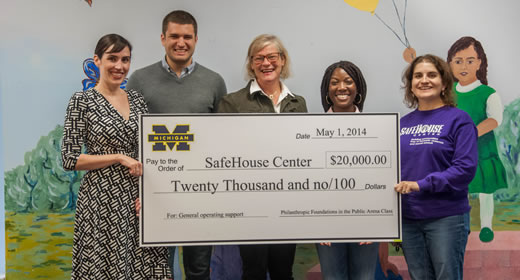
By Miriam Wasserman
Months after the semester ended, many of the students in Megan Tompkins-Stange’s undergraduate philanthropy course still feel connected to the topic, visit the class Facebook page, and attend office hours. Their sustained interest is testament to the deep impact that can be generated when faculty blend classroom learning and real world challenges.
The class tackled the question: what would you do if you had $50,000 to give? More than a thought exercise, a grant from The Philanthropy Lab converted 23 University of Michigan undergraduates into de facto grant officers who had to decide how to allocate the funds and, ultimately, select nonprofit organizations to support.
Tompkins-Stange’s class is part of a growing interest in applied philanthropy. Financed by foundations such as The Philanthropy Lab and Learning By Giving, such courses can be powerful experiences for college students.
Deciding how to allocate the money proved to be a very difficult—at times fraught—question for the students, explains Tompkins-Stange. The only requirement that the foundation placed on the class was that the grantees be 501c3s, so while Tompkins-Stange provided extensive scaffolding through readings, lectures, and debates, she was deliberately laissez-faire about the causes the class would address and the geographical areas the students would focus on. “It actually made the class a lot harder to teach,” she says, “but it generated a ton of teachable moments.”
The students separated into groups with common concerns and interests—halting human trafficking, spurring social entrepreneurship, combatting homelessness, and revitalizing Detroit—then each group researched several organizations.
Once they had whittled down their candidates, they presented their selections and advocated for them in front of the whole class.
Heated debates ensued. Should they aim for lasting impact or cover an urgent need? What was their role as relative novices with the power to impact organizations that had years of experience working in their respective areas?
Discussions were partly fueled by the diversity of the class itself, which included students who shared a passion for social justice and social change but came from different racial, socioeconomic, and philosophical backgrounds. “We had a very vocal group of students informed by critical race theory, and there were other students who had never really considered the idea of ‘white privilege,’ for example,” says Tompkins-Stange. “It kept me on my toes as an instructor to keep it a safe space while also making sure that those voices were all heard.”
The fact that the class had the power and resources to impact real charities instilled a deep sense of responsibility in the students. For John Yim, an undergraduate at the Ford School, the process led him to question his own motivations. “My classmates and I were constantly challenged to reflect and address what really motivated us to give. Do we really desire to advance social justice, or are we merely craving immediate results to feel accomplished?” says Yim.
Although the discussions could be frustrating at times, they were part of the lesson. “I think the most valuable skill I gained from the class was the ability to negotiate with others about emotionally charged topics,” says Ford School BA senior Patrick Sier.
No topic was more difficult than the ultimate decision of who should get the money. The students became very invested in the organizations they were promoting.
“It was difficult to let those relationships go, or to tell them ‘sorry, you haven’t been funded’ when they are doing really great work, they don’t have money, and this (grant) could have really made a big difference,” says Tompkins-Stange. But this was also a lesson in real life. “There are thousands of nonprofits that go underfunded every year that are doing amazing work, and we needed to make hard decisions with real money,” says Sier.
In the end, the students decided to award $25,000 to Freedom House Detroit, an organization that serves indigent refugees seeking legal asylum in the United States; $20,000 to SafeHouse Center, which assists survivors of domestic violence; and $10,000 to Earthworks Urban Farm in Detroit, which grows organic produce for under-served residents and builds community empowerment in the process. (Mid-semester, students were awarded an extra $5,000 from the foundation, increasing their total grants to $55,000).
“I was honestly completely shocked when they called and said that we had been awarded,” says Patrick Crouch, program manager at Earthworks. He had thought of the time he spent with the students as a way to help them with their educational experience rather than a realistic chance of obtaining funds. Now, Earthworks will buy new farming equipment and make some safety upgrades to the facilities.
“I think the ultimate lesson of the class came from our final decisions. Though many people’s first choices were not picked, we all had breakfast at the professor’s house on the final day of class and called the recipients of the grant money, and it seemed we all had a sense of accomplishment,” says Sier. “The fact that we could go through intense discussions about our personal values and come out feeling like we made an impact shows that, even if the nonprofit world isn’t perfect, there is enormous potential for good. I wish more people could have an experience like this.”
Below is a formatted version of this article from State & Hill, the magazine of the Ford School. View the entire Fall 2014 State & Hill here.
